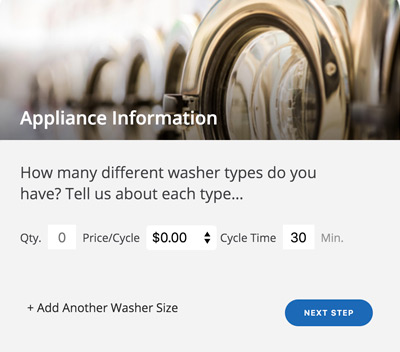
What is “float” and why does it matter?
The unused value or funds left on a self-service laundry “loyalty card” is what those in the laundry industry refer to as “float.” Float is a widespread topic in the laundry industry, which comprises laundromat owners, absentee proprietors, and multi-housing managers.
It is a prevalent topic in laundromats and multi-housing facilities across the country—and on many popular online forums such as PlanetLaundry and CoinWash—because it is one of the chief monetary draws of utilizing a digital card payment system over traditional coin-slot machines.
Can any digital laundry card system accrue float?
Although float is a widely discussed topic among laundromat owners and industry insiders, owners are not always able to reap the benefits of float. With some digital laundry payment systems, there is no ability to add value onto an additional proprietary card that is only usable at their locations. In fact, most laundry payment systems only allow a customer to simply pay for vends using a credit or debit card.
It is only with more sophisticated digital laundry payment systems that float is even a possibility. With these advanced systems, laundromat owners are able to issue what are called “loyalty cards,” which entitle their customers to incentive programs such as big bill bonuses (prepay $20, receive $22 in vend credit; prepay $100, receive $110 in credit), points, and group discounts, with more options and customizations depending on whether the owner chooses to permit clients the option to accept cash and card or credit/debit cards alone. Laundromat owners can even issue “digital” loyalty cards with the help of tools like the FasCard app, which expands the loyalty card’s ability to increase float.
Digital laundry payment system providers also offer premier options for customers with secure touchscreen automated payment kiosks, which dispense loyalty cards, redeem discounts and earned point rewards, and add value to cards—all without an in-store attendant necessary. Plus, owners gain features like live bill count and email notifications.
[loyalty_lc_cta]
Loyalty cards and reloadable gift cards
The process of how float accrues with digital laundry payment cards is comparable that of reloadable gift cards. For instance, in both cases, an amount is prepaid and that amount must be spent using that particular card at locations provided in the terms of its use.
Many major banks and credit card companies, such as VISA, American Express, and MasterCard, and retailers like Amazon, Target, Apple, and Best Buy have incubated this proprietary pre-pay concept, encouraged its rise, and slowly solidified the popularity surrounding personal rechargeable gift cards, in no small part due to the unclaimed money left on these cards.
According to a 2011 report by Brian Riley, analyst for the financial consulting firm, TowerGroup estimated that a reeling $41 billion of gift card funds have gone unredeemed from 2005 to 2011. This figure was so astonishing, The Wall Street Journal picked it as its “Number of the Week” for the end of 2011.
How does float work and can it pay off the investment price of a digital card payment system?
Let’s say a laundromat has a group of customers that each buy a single loyalty card and pre-pay for the laundromat’s services with a large bill. In this scenario—after six months or so—most of those customers eventually leave various amounts of value—for some it’s .75¢ and others it’s $1.50—on each card.
If they never use the remainder of the value on their cards, this means quite a bit of “extra” on-going profit for the laundromat. Even if the float on a single card is equal to a nickel or a dime, every cent is rolled up into a continuous whole. In fact, many digital card laundromat owners report accruing upwards of $1,500 in float each month.
This is especially the case when vend prices are increased incrementally in amounts lower than 25¢. As with many other contentious issues, however, float brings with it differing opinions and on its value, use, and its capacity to be transferred from one store owner to another.
Why is float left on laundry loyalty cards?
There are plenty of reasons for customers not redeeming the value present on their cards, either through card loss, misuse, or by neglecting to bring their old card in with them when they come in to add value to it—and the actual rate of this happening is high.
Benefits of float:
- Research has shown that people spend more money when using a debit or credit card, allowing for a higher overall profit margin.
- Loyalty cards are prepaid and customers are encouraged by bonus programs that are set up to incentivize adding value onto the card in larger dollar amounts, and if that cardholder chooses to patronize a different store, the information gained by a loyalty card allows you to continue to market special offers, deals, and promotions to that loyalty card holder.
- Float can be used if a laundromat owner decides to sell their store, allowing for a more attractive selling point via a higher number of customers—or the float could even be factored into the store’s equity as a bonus.
“‘Float’ alone over time has paid for the entire CCI system.”
If you would like to learn more about Card Concepts Inc.’s (CCI’s) premier digital card payment system, LaundryCard, and how easily the investment costs can be recouped by the float accrued by the system, download our free case study, Bowen Laundromats. In this case study, Bill Bowen explains what it’s like to have a LaundryCard system after utilizing another card system and the major differences between the two.
Card Concepts Inc. is the leading provider of digital laundry payment systems, with completely cashless, card-only systems, including LaundryCard, and the card-and-cash hybrid laundry payment system, FasCard. To learn more about both systems, contact CCI at +1(866) 860-1660.



